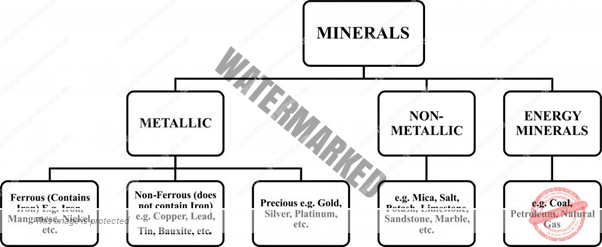- MINERALS AND ENERGY RESOURCES
- ENERGY RESOURCES – FOSSIL FUELS
UNIT 3 – RESOURCES AND ITS UTILIZATION – PART 10
MINERALS AND ENERGY RESOURCES
INTRODUCTION
A mineral is a pure inorganic substance that occurs naturally in the earth’s crust. All of the Earth’s crust, except the rather small proportion of the crust that contains organic material, is made up of minerals. More than two-thousand minerals have been identified and most of these contain inorganic compounds formed by various combinations of the eight elements (O, Si, Al, Fe, Ca, Na, K, and Mg) that make up 98.5% of the Earth’s crust. Industry depends on about 80% of the known minerals.
A mineral deposit is a concentration of naturally occurring Solid, Liquid, Or Gaseous Material, in or on the Earth’s crust in such form and amount that its extraction and its conversion into useful materials or items are profitable now or may be so in the future.
Mineral resources are Non-Renewable and Include Metals (e.g. Iron, Copper, And Aluminium), and NON-METALS (e.g. Salt, Gypsum, Clay, Sand, Phosphates). Minerals are valuable natural resources being finite and non-renewable.
They constitute the vital raw materials for many basic industries and is the primary raw material for energy and fuel which is the driver of economic activity which are a major resource for development.
Management of mineral resources has, therefore, to be closely integrated with the overall strategy of development; and exploitation of minerals is to be guided by long-term national goals and perspectives. Demand for minerals is increasing world-wide as the population increases and the consumption demands of individual people increase. The mining of earth’s natural resources is, therefore accelerating, and it has accompanying environmental consequences.
ENERGY RESOURCES: FOSSIL FUELS
The fossil fuel is the major contributor of the energy consumption in the world. It is a Non-Renewable And Conventional Energy Source. These energy sources are originated from deposition of remains of living organisms buried under ground for millions of years by factors such as pressure, heat and time. These are finite resources that are limited and may deplete in future without replenishment.
FORMATION – Sedimentary Rock formations are the most common geologic environments for storing oil and gas. Carbon Rich Organic Material called PEAT can be formed when vegetation dies and decays in aqueous environments such as swamps. If peat is buried by subsequent geological activity, the buried peat is subjected to increasing temperature and pressure, and peat can eventually be trans-formed into coal by the process of COALIFICATION.
The OIL AND GAS FORMATION begins with the death of microscopic organisms such as algae and bacteria. The remains of the organisms settle into the sediments at the base of an aqueous environment as organic debris. Lakebeds And Seabed’s are examples of favourable sedimentary environments. 5 Environmental Sciences Energy and Environment Fossil fuel classification and composition Subsequent sedimentation buries the organic debris.
The rise and fall of sea level, as well as other geologic processes, continue the process of burying the organic debris. As burial continues, the organic material is subjected to increasing temperature and pressure, and is transformed by bacterial action into oil and gas.
Classification of fossil fuel – The organic materials are heated and compressed over time to form OIL, GAS AND COAL. The fossil fuel can be classified as solid, liquid and gaseous fuel.

